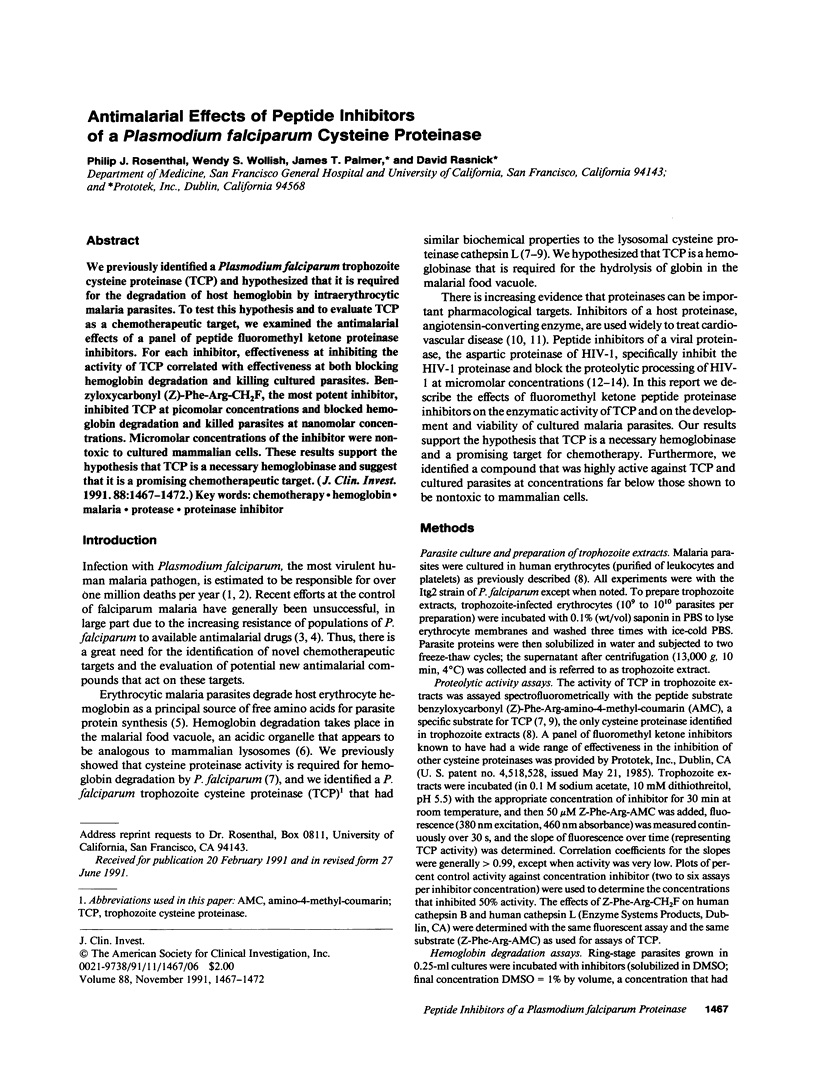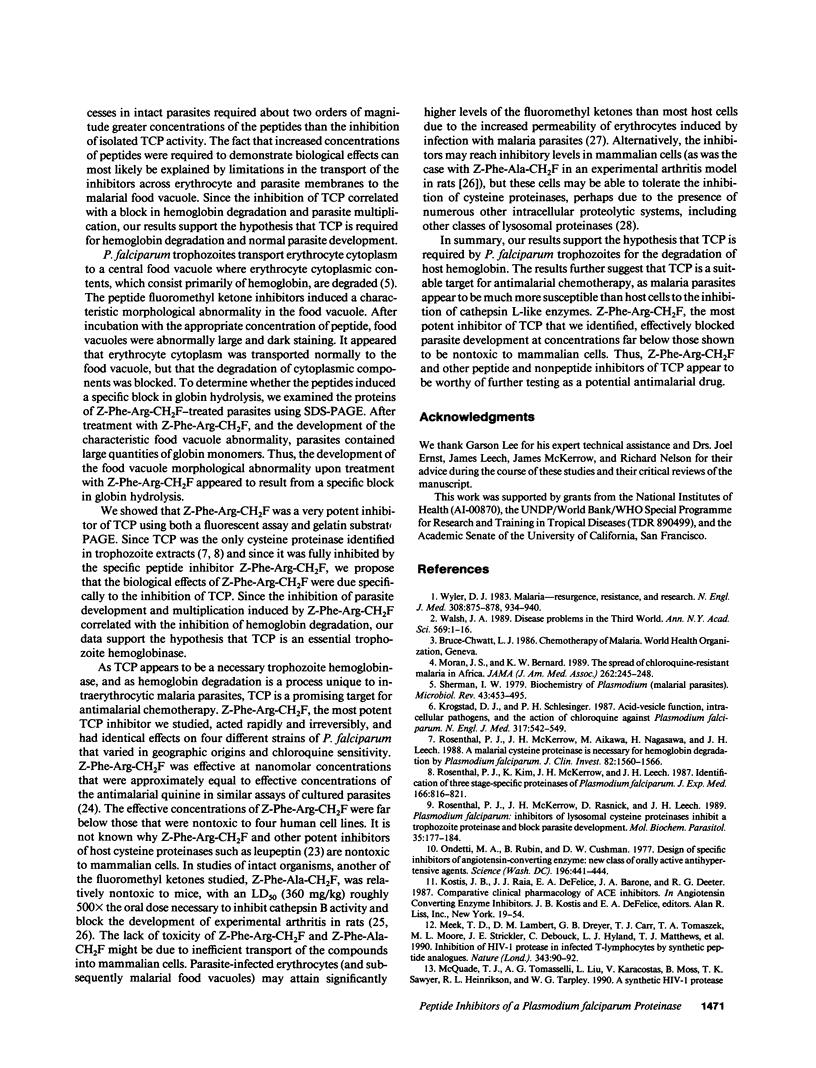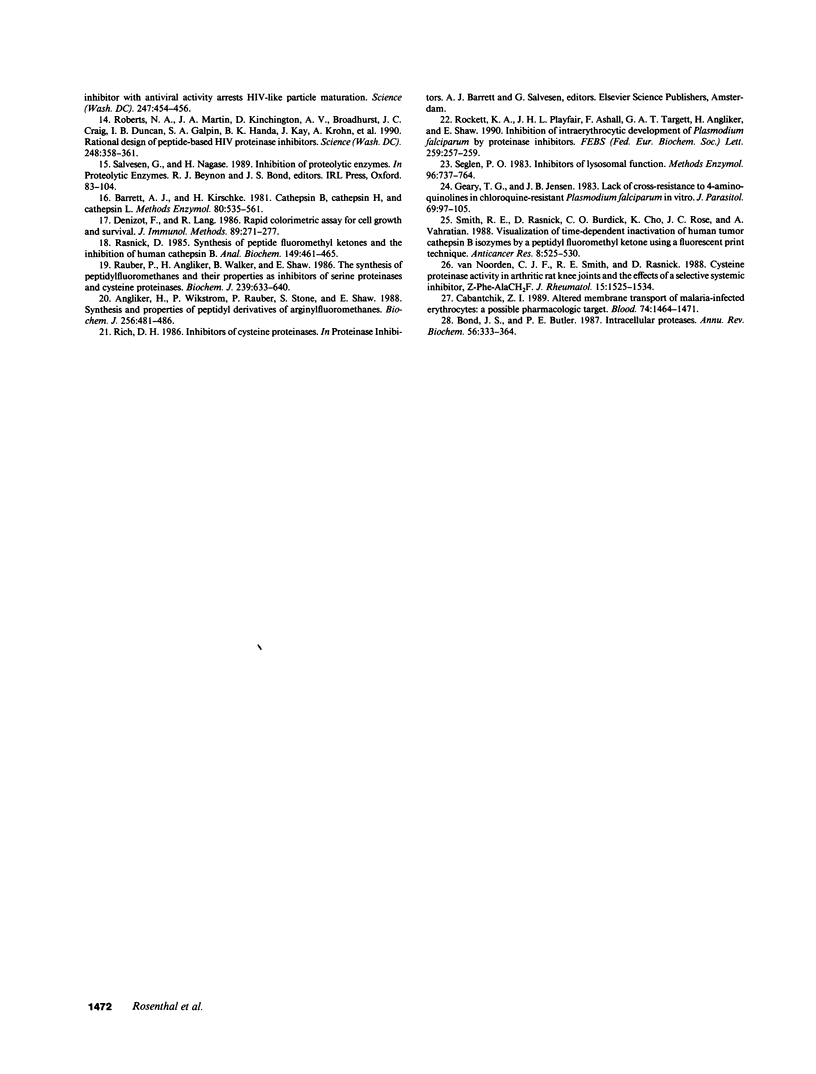Abstract
We previously identified a Plasmodium falciparum trophozoite cysteine proteinase (TCP) and hypothesized that it is required for the degradation of host hemoglobin by intraerythrocytic malaria parasites. To test this hypothesis and to evaluate TCP as a chemotherapeutic target, we examined the antimalarial effects of a panel of peptide fluoromethyl ketone proteinase inhibitors. For each inhibitor, effectiveness at inhibiting the activity of TCP correlated with effectiveness at both blocking hemoglobin degradation and killing cultured parasites. Benzyloxycarbonyl (Z)-Phe-Arg-CH2F, the most potent inhibitor, inhibited TCP at picomolar concentrations and blocked hemoglobin degradation and killed parasites at nanomolar concentrations. Micromolar concentrations of the inhibitor were nontoxic to cultured mammalian cells. These results support the hypothesis that TCP is a necessary hemoglobinase and suggest that it is a promising chemotherapeutic target.
Full text
PDF





Images in this article
Selected References
These references are in PubMed. This may not be the complete list of references from this article.
- Angliker H., Wikström P., Rauber P., Stone S., Shaw E. Synthesis and properties of peptidyl derivatives of arginylfluoromethanes. Biochem J. 1988 Dec 1;256(2):481–486. doi: 10.1042/bj2560481. [DOI] [PMC free article] [PubMed] [Google Scholar]
- Barrett A. J., Kirschke H. Cathepsin B, Cathepsin H, and cathepsin L. Methods Enzymol. 1981;80(Pt 100):535–561. doi: 10.1016/s0076-6879(81)80043-2. [DOI] [PubMed] [Google Scholar]
- Bond J. S., Butler P. E. Intracellular proteases. Annu Rev Biochem. 1987;56:333–364. doi: 10.1146/annurev.bi.56.070187.002001. [DOI] [PubMed] [Google Scholar]
- Cabantchik Z. L. Altered membrane transport of malaria-infected erythrocytes: a possible pharmacologic target. Blood. 1989 Oct;74(5):1464–1471. [PubMed] [Google Scholar]
- Denizot F., Lang R. Rapid colorimetric assay for cell growth and survival. Modifications to the tetrazolium dye procedure giving improved sensitivity and reliability. J Immunol Methods. 1986 May 22;89(2):271–277. doi: 10.1016/0022-1759(86)90368-6. [DOI] [PubMed] [Google Scholar]
- Geary T. G., Jensen J. B. Lack of cross-resistance to 4-aminoquinolines in chloroquine-resistant Plasmodium falciparum in vitro. J Parasitol. 1983 Feb;69(1):97–105. [PubMed] [Google Scholar]
- Krogstad D. J., Schlesinger P. H. Acid-vesicle function, intracellular pathogens, and the action of chloroquine against Plasmodium falciparum. N Engl J Med. 1987 Aug 27;317(9):542–549. doi: 10.1056/NEJM198708273170905. [DOI] [PubMed] [Google Scholar]
- Meek T. D., Lambert D. M., Dreyer G. B., Carr T. J., Tomaszek T. A., Jr, Moore M. L., Strickler J. E., Debouck C., Hyland L. J., Matthews T. J. Inhibition of HIV-1 protease in infected T-lymphocytes by synthetic peptide analogues. Nature. 1990 Jan 4;343(6253):90–92. doi: 10.1038/343090a0. [DOI] [PubMed] [Google Scholar]
- Moran J. S., Bernard K. W. The spread of chloroquine-resistant malaria in Africa. Implications for travelers. JAMA. 1989 Jul 14;262(2):245–248. [PubMed] [Google Scholar]
- Ondetti M. A., Rubin B., Cushman D. W. Design of specific inhibitors of angiotensin-converting enzyme: new class of orally active antihypertensive agents. Science. 1977 Apr 22;196(4288):441–444. doi: 10.1126/science.191908. [DOI] [PubMed] [Google Scholar]
- Rasnick D. Synthesis of peptide fluoromethyl ketones and the inhibition of human cathepsin B. Anal Biochem. 1985 Sep;149(2):461–465. doi: 10.1016/0003-2697(85)90598-6. [DOI] [PubMed] [Google Scholar]
- Rauber P., Angliker H., Walker B., Shaw E. The synthesis of peptidylfluoromethanes and their properties as inhibitors of serine proteinases and cysteine proteinases. Biochem J. 1986 Nov 1;239(3):633–640. doi: 10.1042/bj2390633. [DOI] [PMC free article] [PubMed] [Google Scholar]
- Roberts N. A., Martin J. A., Kinchington D., Broadhurst A. V., Craig J. C., Duncan I. B., Galpin S. A., Handa B. K., Kay J., Kröhn A. Rational design of peptide-based HIV proteinase inhibitors. Science. 1990 Apr 20;248(4953):358–361. doi: 10.1126/science.2183354. [DOI] [PubMed] [Google Scholar]
- Rockett K. A., Playfair J. H., Ashall F., Targett G. A., Angliker H., Shaw E. Inhibition of intraerythrocytic development of Plasmodium falciparum by proteinase inhibitors. FEBS Lett. 1990 Jan 1;259(2):257–259. doi: 10.1016/0014-5793(90)80022-b. [DOI] [PubMed] [Google Scholar]
- Rosenthal P. J., Kim K., McKerrow J. H., Leech J. H. Identification of three stage-specific proteinases of Plasmodium falciparum. J Exp Med. 1987 Sep 1;166(3):816–821. doi: 10.1084/jem.166.3.816. [DOI] [PMC free article] [PubMed] [Google Scholar]
- Rosenthal P. J., McKerrow J. H., Aikawa M., Nagasawa H., Leech J. H. A malarial cysteine proteinase is necessary for hemoglobin degradation by Plasmodium falciparum. J Clin Invest. 1988 Nov;82(5):1560–1566. doi: 10.1172/JCI113766. [DOI] [PMC free article] [PubMed] [Google Scholar]
- Rosenthal P. J., McKerrow J. H., Rasnick D., Leech J. H. Plasmodium falciparum: inhibitors of lysosomal cysteine proteinases inhibit a trophozoite proteinase and block parasite development. Mol Biochem Parasitol. 1989 Jun 15;35(2):177–183. doi: 10.1016/0166-6851(89)90120-5. [DOI] [PubMed] [Google Scholar]
- Seglen P. O. Inhibitors of lysosomal function. Methods Enzymol. 1983;96:737–764. doi: 10.1016/s0076-6879(83)96063-9. [DOI] [PubMed] [Google Scholar]
- Sherman I. W. Biochemistry of Plasmodium (malarial parasites). Microbiol Rev. 1979 Dec;43(4):453–495. doi: 10.1128/mr.43.4.453-495.1979. [DOI] [PMC free article] [PubMed] [Google Scholar]
- Smith R. E., Rasnick D., Burdick C. O., Cho K. J., Rose J. C., Vahratian A. Visualization of time-dependent inactivation of human tumor cathepsin B isozymes by a peptidyl fluoromethyl ketone using a fluorescent print technique. Anticancer Res. 1988 Jul-Aug;8(4):525–529. [PubMed] [Google Scholar]
- Van Noorden C. J., Smith R. E., Rasnick D. Cysteine proteinase activity in arthritic rat knee joints and the effects of a selective systemic inhibitor, Z-Phe-AlaCH2F. J Rheumatol. 1988 Oct;15(10):1525–1535. [PubMed] [Google Scholar]
- Walsh J. A. Disease problems in the Third World. Ann N Y Acad Sci. 1989;569:1–16. doi: 10.1111/j.1749-6632.1989.tb27354.x. [DOI] [PubMed] [Google Scholar]
- Wyler D. J. Malaria--resurgence, resistance, and research (second of two parts). N Engl J Med. 1983 Apr 21;308(16):934–940. doi: 10.1056/NEJM198304213081605. [DOI] [PubMed] [Google Scholar]





